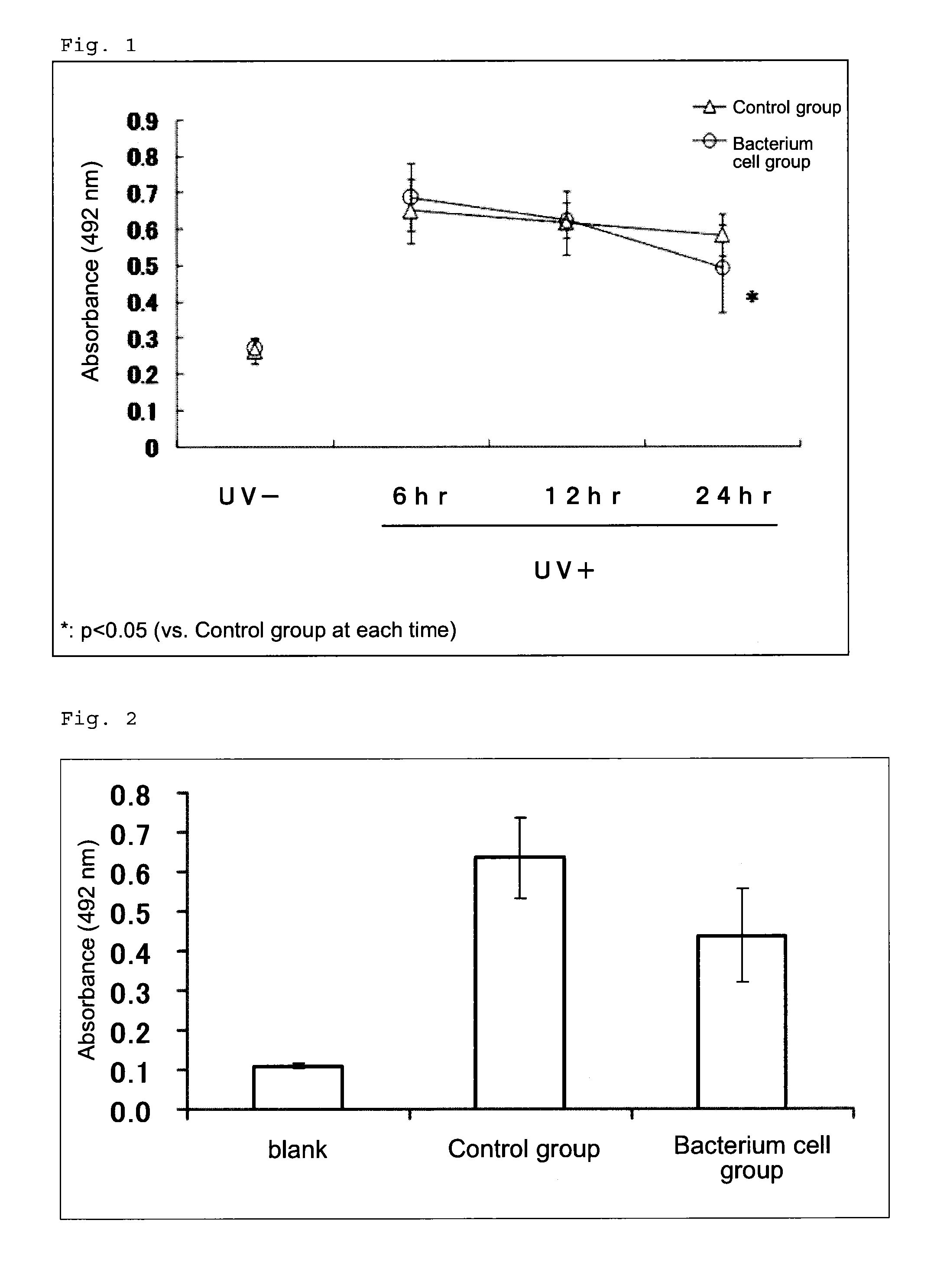DNA damage repair promoter for oral application, and elastase activity inhibitor for oral application
a technology of dna damage repair and promoter, which is applied in the direction of biocide, dermatological disorders, drug compositions, etc., can solve the problems of damage, cancer and aging, abnormality or impairment of such a repair mechanism, etc., and achieve the effect of revitalizing skin, suppressing elastase activity, and promoting dna damage repair
- Summary
- Abstract
- Description
- Claims
- Application Information
AI Technical Summary
Benefits of technology
Problems solved by technology
Method used
Image
Examples
example 1
Preparation of Bacterium Cell Solution)
[0079]The medium disclosed by Rogosa et al. (Eftymiou C. et al., J. Infect. Dis., 110, 258-267, 1962) was modified to have the following composition, and the modified medium was sterilized by heating at 121° C. for 15 minutes. To the sterilized medium, cells of Bifidobacterium breve YIT 4065 (FERM BP-6223) were inoculated at 1 v / v %, and anaerobically cultured at 37° C. for about 20 hours. The thus-obtained culture liquid was centrifuged at 3,500×G, to thereby recover cells of a bacterium belonging to the genus bifidobacterium. The cells were suspended in physiological saline, to thereby prepare a bacterium cell solution having a cell concentration of 1.0×1010 CFU / mL.
Composition of the Medium:
[0080]trypticase: 1%, yeast extract: 0.5%, tryptose: 0.3%, potassium phosphate(I): 0.3%, potassium phosphate(II): 0.39%,
ammonium citrate: 0.2%, lactose: 1%, L-cysteine
hydrochloride: 0.03%, Tween 80: 0.1%, and a salt solution (MgSO4.7H2O: 11.5 g, FeSO4.7H2O...
example 2
Preparation of Bacterium Cell Sample
[0089]A medium was prepared from mineral solution (1 w / v %), yeast extract (1 w / v %), lactose (3 w / v %), and milk protein (5 w / v %). The medium (1.5 L) was added to a 2 L flask and sterilized by heating at 121° C. for 15 minutes. To the sterilized medium, cells of Bifidobacterium breve YIT 12272 (FERN ABP-11320) were inoculated at 1 v / v %, and anaerobically cultured at 36° C. for about 20 hours, while the pH of the culture was maintained at 5.5 by use of sodium hydroxide. The thus-obtained culture liquid was centrifuged at 15,000×G, to thereby recover cells of a bacterium belonging to the genus bifidobacterium. The above mineral solution had the following composition: potassium phosphate(I) (10 w / v %), potassium phosphate(II) (20 w / v %), sodium acetate (30 w / v %), and ammonium sulfate (30 w / v %).
[0090]Separately, a dispersion (100 mL) of milk protein (8 w / v %) and sugar (4 w / v %) was prepared and sterilized by heating at 121° C. for 15 minutes. To...
example 3
Preparation of Bacterium Cell Sample
[0097]A medium was prepared from mineral solution (1 w / v %), yeast extract (1 w / v %), lactose (3 w / v %), and milk protein (5 w / v %). The medium (1.5 L) was added to a 2 L flask and sterilized by heating at 121° C. for 15 minutes. To the sterilized medium, cells of Bifidobacterium breve YIT 4065 (FERM BP-6223) were inoculated at 1 v / v %, and anaerobically cultured at 36° C. for about 20 hours, while the pH of the culture was maintained at 5.5 by use of sodium hydroxide. The thus-obtained culture liquid was centrifuged at 15,000×G, to thereby recover cells of a bacterium belonging to the genus bifidobacterium. The above mineral solution had the following composition: potassium phosphate(I) (10 w / v %), potassium phosphate(II) (20 w / v %), sodium acetate (30 w / v %), and ammonium sulfate (30 w / v %).
[0098]Separately, a dispersion (100 mL) of milk protein (8 w / v %) and sugar (4 w / v %) was prepared and sterilized by heating at 121° C. for 15 minutes. To th...
PUM
 Login to View More
Login to View More Abstract
Description
Claims
Application Information
 Login to View More
Login to View More - R&D
- Intellectual Property
- Life Sciences
- Materials
- Tech Scout
- Unparalleled Data Quality
- Higher Quality Content
- 60% Fewer Hallucinations
Browse by: Latest US Patents, China's latest patents, Technical Efficacy Thesaurus, Application Domain, Technology Topic, Popular Technical Reports.
© 2025 PatSnap. All rights reserved.Legal|Privacy policy|Modern Slavery Act Transparency Statement|Sitemap|About US| Contact US: help@patsnap.com


